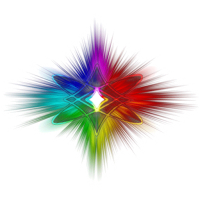One of the three fundamental principles upon which Transformational Presence is based is, “The world is a matrix of relationships.” Everything is connected to everything else. The idea behind the concept “six degrees of separation” is that nothing in the world is separated from something else by more than six connecting points in between. The key is that the power lies in what happens in the connections – in the space in between.
In other words, the world and life in it is all about relationships – relationships between people, between people and situations, between people and ideas or beliefs, between one idea and another or one philosophy and another, between situations and groups, and the list goes on. As leaders and coaches, our most powerful work happens in the relationship space – in the space in between.
The Japanese concept of Ma can help us understand the significance of the space in between. Ma can be described as empty space, as a gap between one thing and another, or as a pause within movement or flow.
Yet it’s much more than just empty space, a gap, or a pause. Ma does not actually describe a physical space created by objects, boundaries, or structures. Instead, Ma describes the essence of the energy or intention that is felt or experienced in that space.
At some point, you have probably walked into a party or event and been quickly swept up in a feeling of excitement and fun. In another place and time, perhaps you walked into a space or situation where you experienced deep peace and calm. Yet in another situation, perhaps you experienced an immediate feeling of discomfort or unease.
What you were experiencing was the Ma of that situation – the energy of what was going on – how it felt to be there.
As another example, there are probably people in your life that feel really good to be with, and others that you prefer to avoid. It’s all about the Ma around that person – the energy or intention that they radiate – or the energy or consciousness of a particular place.
Ma is empty space that can be filled with any possibility. What you project into that space – an object, an intention, or an awareness or understanding – shapes the experience of anyone who enters into or engages with that space. You can intentionally infuse the space around or within a particular situation (the Ma) with a particular energy or consciousness.
For example, in a difficult situation, you might choose to hold a space of clarity, safety, healing, or well being for others. Or in a project team, you might create an innovative environment where people are encouraged to experiment with new approaches and not worry about whether or not they will work. If you are celebrating a big accomplishment for a colleague or friend, you might want to create a festive feeling. It’s about recognizing the Ma that will best support what is needed or wanted in a particular situation, and then infusing the situation with that energy.
When speaking, you can create a particular kind of Ma by your tone of voice, and by the tempo and rhythm of your speech. You might also pause before particular words or phrases to add significance or emphasis.
In music, composers and performers understand that it’s the space in between the notes – not just the notes themselves – that gives deeper meaning and power to the listener’s experience. Different kinds of music create different kinds of Ma.
One kind of Ma might create a feeling of generous space that allows for freedom of movement and breath. Another kind of Ma could create an uncomfortable feeling of the space being too tight or too crowded. Ma can also be the empty space around an object in a room or the empty space in a painting or photograph that gives attention or focus to the object itself.
With intention, the Ma of the moment can be the quiet that many of us need in the midst of our busy lives to find stillness, peace, and meaning in who we are and what we do. In another moment, the Ma might be the energy of a fast-moving, noisy, hectic day.
The point is that we can be conscious about the kind of Ma or energetic space we want to create. We can sense what is needed in the moment – what will serve the situation in the best way – and respond. Do we need stillness and quiet to allow us to drop into deeper awareness, understanding, feelings, and emotions? Or do we need high energy, excitement, and definitive action?
In my research to understand this concept better, I found an old Japanese poem (author unknown) that beautifully illustrates what Ma is:
Thirty spokes meet in the hub,
though the space between them is the essence of the wheel.
Pots are formed from clay,
though the space inside them is the essence of the pot.
Walls with windows and doors form the house,
though the space within them is the essence of the house.
As I was writing, I also remembered when I first read Judy Brown’s poem, “Fire.”
What makes a fire burn
is space between the logs,
a breathing space.
Too much of a good thing,
too many logs
packed in too tight
can douse the flames
almost as surely
as a pail of water would.
So building fires
requires attention
to the spaces in between,
as much as to the wood.
When we are able to build
open spaces
in the same way
we have learned
to pile on the logs,
then we can come to see how
it is fuel, and absence of the fuel
together, that make fire possible.
We only need to lay a log
lightly from time to time.
A fire
grows
simply because the space is there,
with openings
in which the flame
that knows just how it wants to burn
can find its way.
(“Fire” is published in Leading from Within: Poetry That Sustains the Courage to Lead)
Consider a relationship that is important to you. What is the Ma in that relationship – the space in between? What words would you use to describe the energy there? What kind of space are you and the other person or people creating together, whether consciously or unconsciously? As you tune into the relationship itself, what is the Ma that the relationship is asking for?
Then consider a situation that is taking up most of your attention right now. What is the Ma in that situation – the space in between you and the situation itself and the space in between the stakeholders? What is the intentional Ma that the situation is asking for?
Finally, consider the Ma between you and your hopes and dreams. What is the energy in that space? Is that energy serving you and your dreams, or is it getting in the way? What is the intentional Ma that your hopes and dreams need?
The more I work with this concept of Ma, the more I become intentional about the spaces in between in all aspects of my life. I also more fully understand the concept of Ma as a fundamental component of Transformational Presence. It gives us a simple yet powerful way to create clear, intentional, and supportive spaces in between us and the people and situations in our lives and work.
~ ~ ~
If you enjoyed this blog post and found it helpful or inspiring, please share it with your friends on social media by clicking on the icons below. You are also welcome to make a comment below.
You may subscribe to our free weekly newsletter by clicking here.
Related Blog Posts:
- Love As an Intentional Space
- Holding Fast to Love – Being a Transformational Presence in Disruptive Times
- The Liminal Space – Embracing the Mystery and Power of the Transition From What Has Been to What Will Be





































